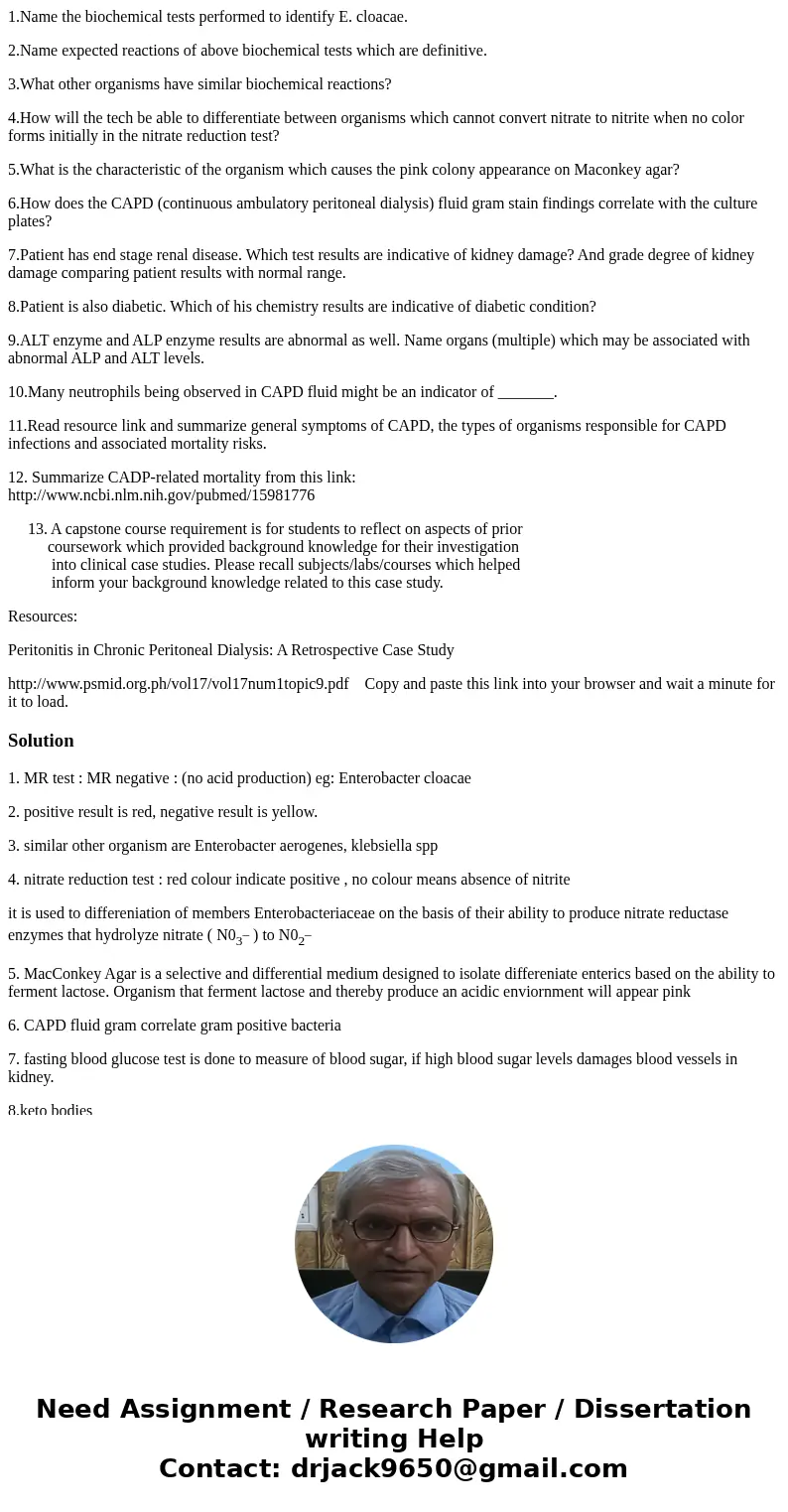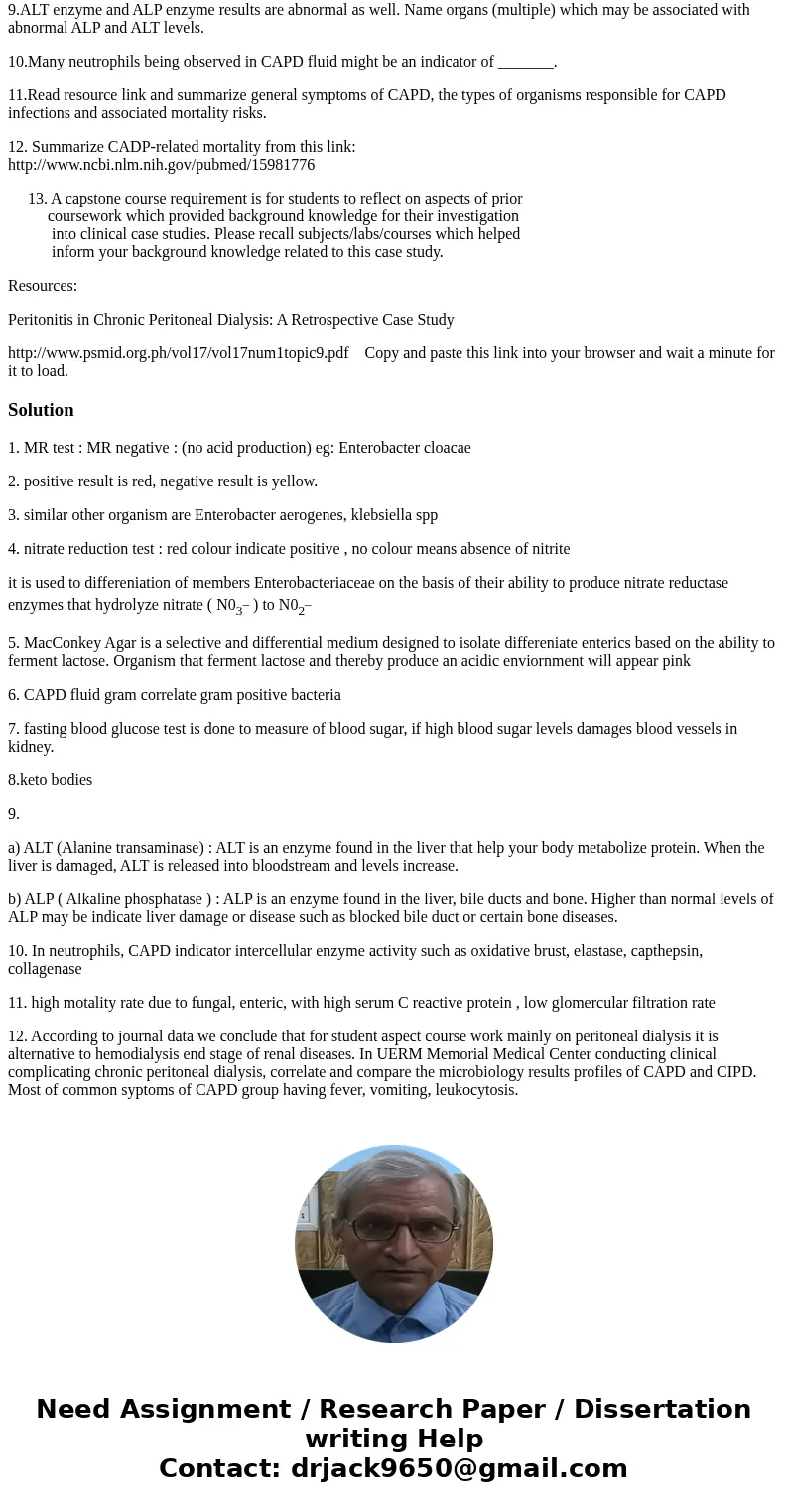1Name the biochemical tests performed to identify E cloacae
1.Name the biochemical tests performed to identify E. cloacae.
2.Name expected reactions of above biochemical tests which are definitive.
3.What other organisms have similar biochemical reactions?
4.How will the tech be able to differentiate between organisms which cannot convert nitrate to nitrite when no color forms initially in the nitrate reduction test?
5.What is the characteristic of the organism which causes the pink colony appearance on Maconkey agar?
6.How does the CAPD (continuous ambulatory peritoneal dialysis) fluid gram stain findings correlate with the culture plates?
7.Patient has end stage renal disease. Which test results are indicative of kidney damage? And grade degree of kidney damage comparing patient results with normal range.
8.Patient is also diabetic. Which of his chemistry results are indicative of diabetic condition?
9.ALT enzyme and ALP enzyme results are abnormal as well. Name organs (multiple) which may be associated with abnormal ALP and ALT levels.
10.Many neutrophils being observed in CAPD fluid might be an indicator of _______.
11.Read resource link and summarize general symptoms of CAPD, the types of organisms responsible for CAPD infections and associated mortality risks.
12. Summarize CADP-related mortality from this link:
http://www.ncbi.nlm.nih.gov/pubmed/15981776
13. A capstone course requirement is for students to reflect on aspects of prior
coursework which provided background knowledge for their investigation
into clinical case studies. Please recall subjects/labs/courses which helped
inform your background knowledge related to this case study.
Resources:
Peritonitis in Chronic Peritoneal Dialysis: A Retrospective Case Study
http://www.psmid.org.ph/vol17/vol17num1topic9.pdf Copy and paste this link into your browser and wait a minute for it to load.
Solution
1. MR test : MR negative : (no acid production) eg: Enterobacter cloacae
2. positive result is red, negative result is yellow.
3. similar other organism are Enterobacter aerogenes, klebsiella spp
4. nitrate reduction test : red colour indicate positive , no colour means absence of nitrite
it is used to differeniation of members Enterobacteriaceae on the basis of their ability to produce nitrate reductase enzymes that hydrolyze nitrate ( N03_ ) to N02_
5. MacConkey Agar is a selective and differential medium designed to isolate differeniate enterics based on the ability to ferment lactose. Organism that ferment lactose and thereby produce an acidic enviornment will appear pink
6. CAPD fluid gram correlate gram positive bacteria
7. fasting blood glucose test is done to measure of blood sugar, if high blood sugar levels damages blood vessels in kidney.
8.keto bodies
9.
a) ALT (Alanine transaminase) : ALT is an enzyme found in the liver that help your body metabolize protein. When the liver is damaged, ALT is released into bloodstream and levels increase.
b) ALP ( Alkaline phosphatase ) : ALP is an enzyme found in the liver, bile ducts and bone. Higher than normal levels of ALP may be indicate liver damage or disease such as blocked bile duct or certain bone diseases.
10. In neutrophils, CAPD indicator intercellular enzyme activity such as oxidative brust, elastase, capthepsin, collagenase
11. high motality rate due to fungal, enteric, with high serum C reactive protein , low glomercular filtration rate
12. According to journal data we conclude that for student aspect course work mainly on peritoneal dialysis it is alternative to hemodialysis end stage of renal diseases. In UERM Memorial Medical Center conducting clinical complicating chronic peritoneal dialysis, correlate and compare the microbiology results profiles of CAPD and CIPD. Most of common syptoms of CAPD group having fever, vomiting, leukocytosis.


 Homework Sourse
Homework Sourse